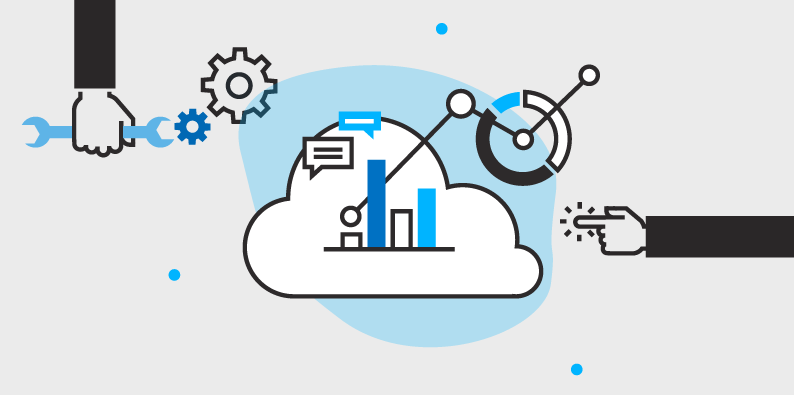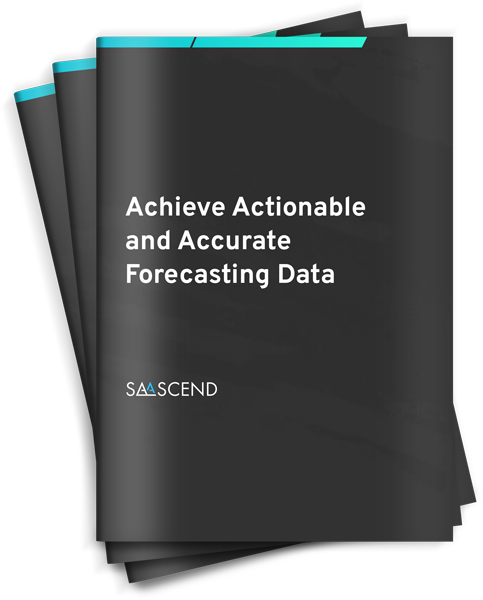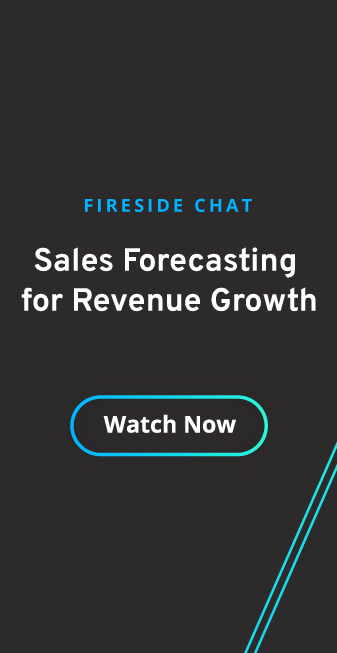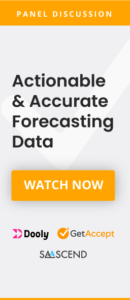Having access to accurate forecasting data is critical for any sales leader to be able to plan for future growth, coach the sales team, and set quota attainment goals. However, accurate sales forecasting data can be difficult to obtain.
According to the 2021 State of Sales Forecasting report by InsightSquared, “only 15% of revenue leaders are satisfied with their forecast process,” and 91% shared that their predicted forecast is six percent or more off from actual results.
Meaning that the majority of sales leaders are not getting access to the accurate and actionable forecasting that they need. To do so can seem like an uphill climb.
Sales leaders have to keep sales representatives accountable for data entry and updating their opportunities, while sifting through a bloated pipeline and inaccurate probability information, and then attempt to compile everything into reports where they can visualize trends and analyze data, which can seem insurmountable.
To overcome these challenges and obtain accurate and actionable data, there are seven sales forecasting techniques that Craig Jordan shared on a fireside chat that teams can use to achieve the insights they need.
7 Sales Forecasting Techniques
❶ Define your sales process to have standardized stages.
Have a sales process defined for your deal cycles with stages and structure in a linear progression, so that at any point and time, sales can answer, where is the deal? The sales process will depend on how you sell, whether Transactional, Standard, or Enterprise.
Transactional | No stages
Standard | 30 – 180 day sales cycles with 5 – 6 stages
Enterprise | More stages and longer sales cycles
A standard sales process typically involves the following stages, Introduction, Demo/Discovery, Proposal, Contract, and then Won / Loss (fig. 1) Whichever your stages are, they should be defined in your CRM system and the stage of the opportunity should be updated as it moves through the process.

Figure 1
❷ Use forecast categories to quickly identify the deals that will close within the month.
Forecast Categories are used for sales team members to share their insight on an opportunity to categorize the deals that are going to close within the month.
Craig advised using no more than four categories, recommended below.
-
-
- Pipeline – Live and actively working
- Commit – This deal will close to the best of my ability this month.
- Omit – This deal is being pushed, or has taken a turn in the wrong direction.
- Won – The deal is Closed Won.
-
Sales leaders can use these categories for a quick view to see, of all the open opportunities for the month, which ones will actually close within the month and which ones the sales team is actively working on, understanding if they are on track for their goal or behind.
Forecasting categories can be implemented as a field on the Opportunity that sales team members should update, for example, before every sales sync or pipeline review call.
❸ Use standardization based off of the deal progression and mutual action plans for probability.
Teams are typically going to close 20 – 30% of the deals that are in the pipeline. Therefore, if all of the probability data is marked above 60% – 70%, then there needs to be a conversation of why that is.
The sales process stages can be used to have the probability field automatically update with a standard value based on the stage of the opportunity. Sales team members can then use gut feel as a supplement to the automation.
Craig likes to coach his sales reps to be more conservative with their forecasting. If a deal is marked with high probability, the salesperson should be able to give reasoning behind it. This reasoning should come from the mutual action plan that they have with the prospect.
A mutual action plan is a series of defined steps that the seller will go through with the buyer. The main two questions to be aligned on for accurate probability data are:
-
-
- What is your timeline?
- Who will be the signer on the contract?
-
If the prospect comes to the meeting, has high urgency and will also be the signer on the contract, then the deal can more confidently be given a higher probability with a closer close date. If the contract will still have to go through three levels of approval then probability should be more conservative with a farther out close date.

Build Pipeline Quickly with Former Customers at their New Companies
❹ Structure data to be able to track deal progression from stage to stage.
The goal of this is to be able to answer the below questions:
-
-
- What is our sales cycle velocity from start to finish?
- What is the velocity and rate of conversion between each stage?
- Are there certain sales reps that are closing deals faster than others?
- Are certain sales reps stalling at particular stages?
-
Understanding the answers to these questions, gives sales leaders the ability to identify areas for optimization and act fast. Timestamp fields on the opportunity that are automatically updated based on when the opportunity advances to the next stage can be used, so that teams can track the delta between each stage to understand the amount of days the deal was in a particular stage and know how fast it is progressing through the pipeline.
Funnel velocity data can aid in sales coaching and also having a baseline to compare to when looking at opportunity close dates for forecasting. If there are a large portion of opportunities that are set to close far outside of the company’s typical sales cycle then there needs to be further investigation into why this is happening, the same if there were deals marked within an alarmingly short amount of time in comparison to the typical sales cycle.
❺ Know when deals are falling out of your pipeline.
Is there a trend that deals are being lost in a particular stage or when they become marked as dead? This connects back to tracking the rate of conversion as the deal progresses from stage to stage. If there is a notable drastic change from one stage to the next, then this implies there is a leaky funnel.
Pinpoint the stage and then work with the sales team and operations to optimize processes for a better conversion rate to keep deals progressing.

❻ Have the functionality in place to measure gross vs. net.
As typically 1 in 3 of deals in the pipeline will become closed won, then your forecasting should reflect this. For example, if a deal is in the pipeline for the amount of $300,000 (gross), then only $100,000 (net) should be forecasted because you are committing to a smaller percentage based off of the probability of the larger collective.
Forecasting off of the net amount will foster more accurate data for what will realistically close.

❼ Structure your data visualization to view numbers for this quarter and the quarter ahead.
The efforts that the sales team is putting in now will affect performance in the next quarter. Having this insight will enable sales leaders to coach and pivot for greater impact.
A baseline, best practice dashboard should include:
-
-
- A daily breakdown of where the sales team is in terms of meeting their goal. If you are using a gauge, and the goal is all the way to the right, how far are you from that goal?
- Expected pipeline using net opportunity amounts.
- Trends on how the team is performing quarter over quarter.
- Different lenses based on if the business sells different products, or into different territories, etc.
- Accurate close date data, meaning no close dates in the past.
-
Check Your Current Sales Forecasting Process
-
-
- Are there defined opportunity stages in the CRM?
Are you using forecast categories? - Is there automation in place to help standardize probability data based on deal progression?
- Are your sales representatives using mutual action plans or getting the timeline and identifying the signer on every deal from the start?
- Do you have any opportunity close dates in the past?
- Are you able to tell how fast deals are progressing through your funnel?
- Do you know when deals are falling out of your pipeline?
- Do you have mechanisms in place to automatically forecast off of the net instead of gross?
- Are there defined opportunity stages in the CRM?
-
Answering these questions can help identify the areas to start with for implementing these 7 sales forecasting techniques. To do it all at once seems overwhelming, but starting with one area and then moving on to the next will aid in incremental optimizations to then achieve accurate and actionable data.

Get Access to Better Data & Attain Funnel Predictability



